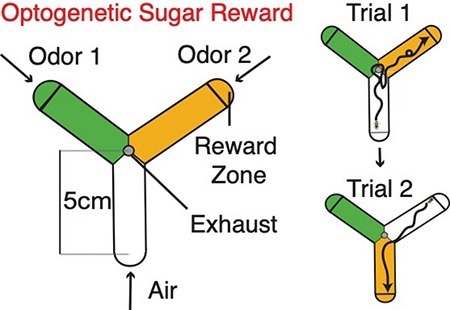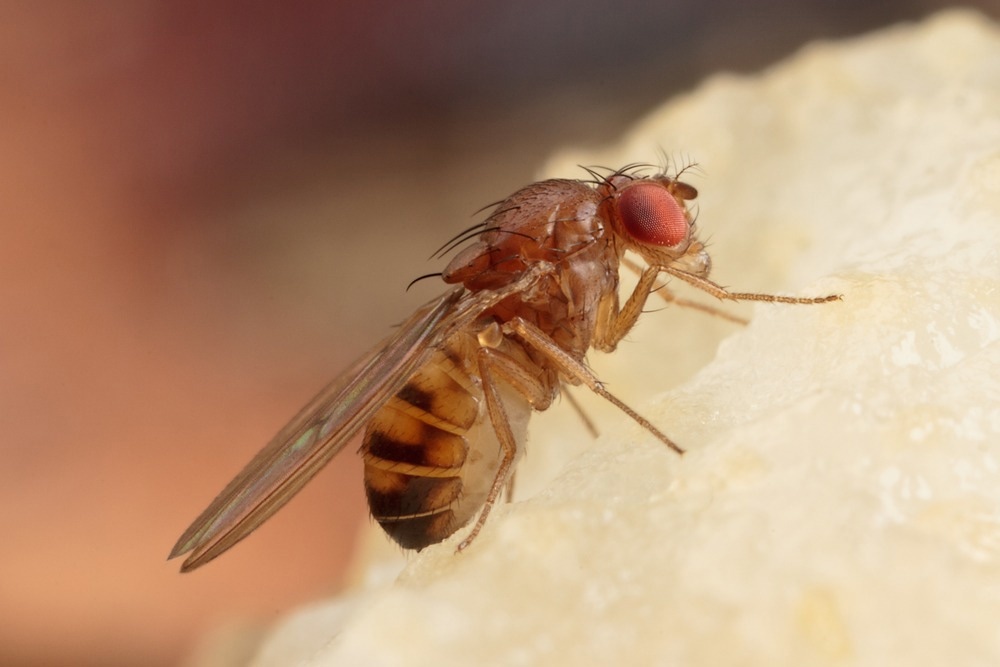Reviewed by Danielle Ellis, B.Sc.Sep 25 2023
Fitzgerald’s brother-in-law, like many L.P. record collectors, has a go-to store where he routinely finds the greatest vinyl for his collection. But occasionally he spends hours in the store and leaves empty-handed. He is also aware that on sometimes he should visit the record shop on the opposite side of town, where he occasionally finds a rare treasure that has been added to the shelves since his previous visit.
 Schematic of the Y-arena for single flies. A fly begins a trial in one arm of the Y filled with clean odor-free air and chooses between two other arms randomly assigned different odors. Once a fly makes its way up one of the odorized arms and crosses into the reward zone, a reward is provided according to reward contingencies of the task by activating the fly’s sugar-sensing neurons. The Y then resets so that the arm that was chosen is filled with clean air and the other two arms are randomly assigned odors. Image Credit: Rajagopalan et al.
Schematic of the Y-arena for single flies. A fly begins a trial in one arm of the Y filled with clean odor-free air and chooses between two other arms randomly assigned different odors. Once a fly makes its way up one of the odorized arms and crosses into the reward zone, a reward is provided according to reward contingencies of the task by activating the fly’s sugar-sensing neurons. The Y then resets so that the arm that was chosen is filled with clean air and the other two arms are randomly assigned odors. Image Credit: Rajagopalan et al.
The calculation Fitzgerald’s brother-in-law is performing is calculating the likely consequences of directing his actions. He frequents his favorite record store the most since it rewards him most regularly. He rarely shops at the second-tier store since he is less likely to receive rewards there.
This “record foraging” activity, according to Glenn Turner, a neuroscientist and group leader at HHMI’s Janelia Research Campus, is a prime example of a form of behavior termed matching that is common in the animal realm. Non-hipster creatures like mice and flies seek food instead of playing vinyl, utilizing sensory clues like smells to assess the quality of the food from a distance.
It was not known how the brain made these value-based decisions, despite the fact that matching has been seen in pigeons, mice, and humans. A notion of how that could happen has previously been put out by researchers, but it had never been put to the test in the actual world.
The suggested hypothesis has now been validated by a group of Janelia researchers, including Fitzgerald, Turner, Janelia Graduate Scholar Adithya Rajagopalan, former Janelia Fellow Ran Darshan, and Research Specialist Karen Hibbard.

Image Credit: Ant Cooper/Shutterstock.com
Rajagopalan’s research shows that fruit flies can make decisions based on their expectations of the chance of a reward, just like Fitzgerald’s brother-in-law. The team was able to directly test this notion at the level of neural circuits because they were able to identify the location in the fly brain where these value modifications are done.
We found that flies are using expectation to assign value to their world. It also really nicely connects back to this theoretical work that was so elegant and explains this widespread phenomenon.”
Glenn Turner, Group Leader and Director, GENIE Project Team, Howard Hughes Medical Institute
Understanding how the fly brain performs this common function might help scientists better understand how similar decision-making occurs in larger species’ brains, including humans. According to the researchers, knowing how this mechanism works in simpler brains has broad importance since decision-making goes awry in disorders like addiction.
The kinds of ideas and the theoretical framework that we have identified in this paper feel like a seed for evolution to build on in larger organisms, where more layers are added to allow for more complex behaviors.”
Adithya Rajagopalan, Study First Author and Graduate Scholar, Howard Hughes Medical Institute
Investigating Matching Behavior
Fruit flies, with well-studied and mapped brains, were an enticing candidate for studying matching and its underlying mechanics. But first, the scientists needed to devise a method for observing fruit fly decisions.
The study was directed by Rajagopalan, who came to the Turner Lab through a collaborative graduate program with Johns Hopkins University. He devised an experiment in which a single fly is introduced into one arm of a symmetrical Y-shaped arena. Odors are injected into the Y’s other two arms.
The fly chooses between two odors and is rewarded - in this example, by having its sugar-sensing neurons activated–but with varying probabilities: One odor can result in a reward 80% of the time, whereas the other odor can result in a reward 20% of the time.
The researchers discovered that the fly learned to expect rewards in the same proportions as they were delivered and then chose based on those expectations. These behaviors give the matching behavior its name: the fly picked the odor that offers 80 percent of the rewards 80 percent of the time. And it picked the odor that delivers 20% of the rewards 20% of the time.
The behavior was traced back to synapses in the mushroom body, an area of the fly brain responsible for learning and memory. Based on the idea of matching, they were able to develop a model of how the brain performs this activity.
Synaptic connections are strengthened or decreased in proportion to the difference between predicted and experienced reward, according to this notion. Based on this hypothesis and the behavior of the fly, the team’s model demonstrated how individual synapses change to enable value-based decision-making.
The new work highlights an important interplay between experiment and theory, getting closer to describing the rules governing animal learning, a result that the researchers say is satisfying on both a conceptual and mechanistic level.
To be able to see that you can get these sophisticated economic decisions through this simple mechanistic explanation about how synapses are changing is a great illustration of what mechanistic cognitive neuroscience can mean. We are taking this universal property and using the strengths of these small animals to really nail it mechanistically.”
James Fitzgerald, Group Leader, Howard Hughes Medical Institute
Source:
Journal reference:
Rajagopalan, A. E., et al. (2023). Reward expectations direct learning and drive operant matching in Drosophila. PNAS. doi.org/10.1073/pnas.2221415120